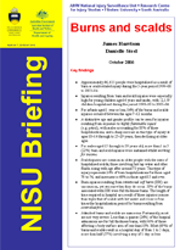Summary
- Approximately 46, 611 people were hospitalised as a result of burn or scald-related injury during the 5-year period 1999–00 to 2003–04.
- Injuries resulting from burn and scald injuries were especially high for young children aged 4 years and under, with 12,159 children hospitalised during the period 1999–00 to 2003–04.
- For infants aged 1 year or less, 84% of the burns and scalds injuries occurred between the ages 7–12 months.
- A distinctive age and gender profile can be seen for injuries resulting from exposure to highly flammable liquid (e.g. petrol), with males accounting for 88% of these hospitalisations, and a sharp increase in this type of injury at ages 10–14 through to 25–29 years, then declining at older ages.
- For males aged 15 through to 39 years old, more than 1 in 5 (22%) burn and scald injuries were sustained whilst working for income.
- Scald injuries are common in older people with the rates of hospitalised scalds, those involving hot tap water and other fluids, rising with age after around 70 years. This type of injury represents 24% of burn hospitalisations for those aged 70 to 74, and increases to 40% in those aged 85 and over.
- Burn injuries resulting from intentional self harm (ISH) are uncommon, yet serious when they do occur. 30% of the burns associated with ISH were full thickness burns. The length of time required in hospital as a result of these injuries is more than triple that of scalds with hot water and close to four times the hospitalisation period for burns resulting from controlled fires.
- Admitted burns and scalds are numerous. Fortunately, most are not very severe. Less than a quarter (24%) of the hospital admissions are for full thickness burns, with 96% of those affecting a body surface area of less than 10%. Most (69%) of burns and scalds result in a hospital stay of from 1 to 3 days, more than half (57%) involving a stay of 1 day or less.
Hospitalisations Australia 1999–2000 to 2003–2004
Age and gender
External causes of burn and scald injuries
Groups most at risk
Scalds in children aged 4 years and under
Activity-related pattern of burn injuries for young males
Burns and scalds in the elderly
Intentional self-harm
Length of stay and burn severity
Other studies
Discussion
End matter: References; Data issues; Case inclusion criteria; Age adjustment; External causes not otherwise listed; Costs of burns and scalds; Data quality



